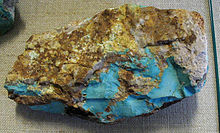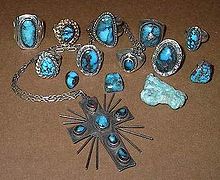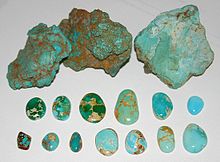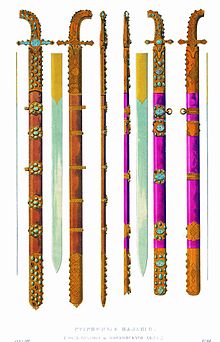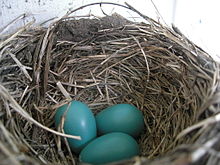- Turquoise
-
For other uses, see Turquoise (disambiguation).
Turquoise 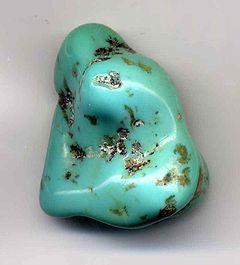
Turquoise (tumble finished) one inch (25 mm) long. This pebble is greenish and therefore low gradeGeneral Category Phosphate minerals Chemical formula CuAl6(PO4)4(OH)8·4H2O Strunz classification 08.DD.15 Identification Colour Blue, blue-green, green Crystal habit Massive, nodular Crystal system Triclinic Cleavage Good to perfect – usually N/A Fracture Conchoidal Mohs scale hardness 5-7 Lustre Waxy to subvitreous Streak Bluish white Specific gravity 2.6-2.9 Optical properties Biaxial (+) Refractive index nα = 1.610 nβ = 1.615 nγ = 1.650 Birefringence +0.040 Pleochroism Weak Fusibility Fusible in heated HCl Solubility Soluble in HCl References [1][2][3] Turquoise is an opaque, blue-to-green mineral that is a hydrous phosphate of copper and aluminium, with the chemical formula CuAl6(PO4)4(OH)8·4H2O. It is rare and valuable in finer grades and has been prized as a gem and ornamental stone for thousands of years owing to its unique hue. In recent times, turquoise, like most other opaque gems, has been devalued by the introduction of treatments, imitations, and synthetics onto the market.
The substance has been known by many names, but the word turquoise, which dates to the 16th century, is derived from an Old French word for "Turkish", because the mineral was first brought to Europe from Turkey, from the mines in historical Khorasan Province of Persia.[2][3][4][5] Pliny referred to the mineral as callais, the Iranians named it "pirouzeh" and the Aztecs knew it as chalchihuitl.[4]
Contents
Properties of turquoise
Even the finest of turquoise is fracturable, reaching a maximum hardness of just under 6, or slightly more than window glass.[2] Characteristically a cryptocrystalline mineral, turquoise almost never forms single crystals and all of its properties are highly variable. Its crystal system is proven to be triclinic via X-ray diffraction testing. With lower hardness comes lower specific gravity (2.60–2.90) and greater porosity: These properties are dependent on grain size. The lustre of turquoise is typically waxy to subvitreous, and transparency is usually opaque, but may be semitranslucent in thin sections. Colour is as variable as the mineral's other properties, ranging from white to a powder blue to a sky blue, and from a blue-green to a yellowish green. The blue is attributed to idiochromatic copper while the green may be the result of either iron impurities (replacing aluminium) or dehydration.
The refractive index (as measured by sodium light, 589.3 nm) of turquoise is approximately 1.61 or 1.62; this is a mean value seen as a single reading on a gemmological refractometer, owing to the almost invariably polycrystalline nature of turquoise. A reading of 1.61–1.65 (birefringence 0.040, biaxial positive) has been taken from rare single crystals. An absorption spectrum may also be obtained with a hand-held spectroscope, revealing a line at 432 nanometres and a weak band at 460 nanometres (this is best seen with strong reflected light). Under longwave ultraviolet light, turquoise may occasionally fluoresce green, yellow or bright blue; it is inert under shortwave ultraviolet and X-rays.
Turquoise is insoluble in all but heated hydrochloric acid. Its streak is a pale bluish white and its fracture is conchoidal, leaving a waxy lustre. Despite its low hardness relative to other gems, turquoise takes a good polish. Turquoise may also be peppered with flecks of pyrite or interspersed with dark, spidery limonite veining.
Formation
As a secondary mineral, turquoise apparently forms by the action of percolating acidic aqueous solutions during the weathering and oxidation of pre-existing minerals. For example, the copper may come from primary copper sulfides such as chalcopyrite or from the secondary carbonates malachite or azurite; the aluminium may derive from feldspar; and the phosphorus from apatite. Climate factors appear to play an important role as turquoise is typically found in arid regions, filling or encrusting cavities and fractures in typically highly altered volcanic rocks, often with associated limonite and other iron oxides. In the American southwest turquoise is almost invariably associated with the weathering products of copper sulfide deposits in or around potassium feldspar bearing porphyritic intrusives. In some occurrences alunite, potassium aluminium sulfate, is a prominent secondary mineral. Typically turquoise mineralization is restricted to a relatively shallow depth of less than 20 metres (66 ft), although it does occur along deeper fracture zones where secondary solutions have greater penetration or the depth to the water table is greater.
Although the features of turquoise occurrences are consistent with a secondary or supergene origin, some sources refer to a hypogene origin. The hypogene hypothesis, which holds that the aqueous solutions originate at significant depth, from hydrothermal processes. Initially at high temperature, these solutions rise upward to surface layers, interacting with and leaching essential elements from pre-existing minerals in the process. As the solutions cool, turquoise precipitates, lining cavities and fractures within the surrounding rock. This hypogene process is applicable to the original copper sulfide deposition; however, it is difficult to account for the many features of turquoise occurrences by a hypogene process. That said, there are reports of two phase fluid inclusions within turquoise grains that give elevated homogenization temperatures of 90 to 190 °C that require explanation.
Turquoise is nearly always cryptocrystalline and massive and assumes no definite external shape. Crystals, even at the microscopic scale, are exceedingly rare. Typically the form is vein or fracture filling, nodular, or botryoidal in habit. Stalactite forms have been reported. Turquoise may also pseudomorphously replace feldspar, apatite, other minerals, or even fossils. Odontolite is fossil bone or ivory that has been traditionally thought to have been altered by turquoise or similar phosphate minerals such as the iron phosphate vivianite. Intergrowth with other secondary copper minerals such as chrysocolla is also common.
Occurrence
Turquoise was among the first gems to be mined, and while many historic sites have been depleted, some are still worked to this day. These are all small-scale, often seasonal operations, owing to the limited scope and remoteness of the deposits. Most are worked by hand with little or no mechanization. However, turquoise is often recovered as a byproduct of large-scale copper mining operations, especially in the United States.
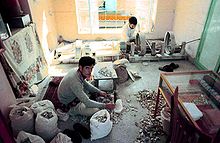 Cutting and grinding turquoise in Nishapur, Iran, 1973
Cutting and grinding turquoise in Nishapur, Iran, 1973
Iran
For at least 2,000 years, the region once known as Persia has remained an important source of turquoise which was named by Iranians initially "pirouzeh" meaning "victory" and later after Arab invasion "firouzeh".[citation needed] In Iranian architecture, the blue turquoise was used to cover the domes of the Iranian palaces because its intense blue colour was also a symbol of heaven on earth.[citation needed]
This deposit, which is blue naturally, and turns green when heated due to dehyration, is restricted to a mine-riddled region in Nishapur, the 2,012-metre (6,601 ft) mountain peak of Ali-mersai, which is tens of kilometers from Mashhad, the capital of Khorasan province, Iran. A weathered and broken trachyte is host to the turquoise, which is found both in situ between layers of limonite and sandstone, and amongst the scree at the mountain's base. These workings, together with those of the Sinai Peninsula, are the oldest known.[5]
Sinai
Since at least the First Dynasty (3000 BCE), and possibly before then, turquoise was used by the Egyptians and was mined by them in the Sinai Peninsula, called "Country of Turquoise" by the native Monitu. There are six mines in the region, all on the southwest coast of the peninsula, covering an area of some 650 square kilometres (250 sq mi). The two most important of these mines, from a historic perspective, are Serabit el-Khadim and Wadi Maghareh, believed to be among the oldest of known mines. The former mine is situated about 4 kilometres from an ancient temple dedicated to Hathor.
The turquoise is found in sandstone that is, or was originally, overlain by basalt. Copper and iron workings are present in the area. Large-scale turquoise mining is not profitable today, but the deposits are sporadically quarried by Bedouin peoples using homemade gunpowder. In the rainy winter months, miners face a risk from flash flooding; even in the dry season, death from the collapse of the haphazardly exploited sandstone mine walls is not unheard of. The colour of Sinai material is typically greener than Iranian material, but is thought to be stable and fairly durable. Often referred to as Egyptian turquoise, Sinai material is typically the most translucent, and under magnification its surface structure is revealed to be peppered with dark blue discs not seen in material from other localities.
United States
 A selection of Ancestral Puebloan (Anasazi) turquoise and orange argillite inlay pieces from Chaco Canyon (dated ca. 1020–1140 CE) show the typical colour range and mottling of American turquoise.
A selection of Ancestral Puebloan (Anasazi) turquoise and orange argillite inlay pieces from Chaco Canyon (dated ca. 1020–1140 CE) show the typical colour range and mottling of American turquoise.
The Southwest United States is a significant source of turquoise; Arizona, California (San Bernardino, Imperial, Inyo counties), Colorado (Conejos, El Paso, Lake, Saguache counties), New Mexico (Eddy, Grant, Otero, Santa Fe counties) Nevada (Clark, Elko, Esmeralda County, Eureka, Lander, Mineral County and Nye counties) are (or were) especially rich. The deposits of California and New Mexico were mined by pre-Columbian Native Americans using stone tools, some local and some from as far away as central Mexico. Cerrillos, New Mexico is thought to be the location of the oldest mines; prior to the 1920s, the state was the country's largest producer; it is more or less exhausted today. Only one mine in California, located at Apache Canyon, operates at a commercial capacity today.
The turquoise occurs as vein or seam fillings, and as compact nuggets; these are mostly small in size. While quite fine material—rivalling Iranian material in both colour and durability—is sometimes found, most American turquoise is of a low grade (called "chalk turquoise"); high iron levels mean greens and yellows predominate, and a typically friable consistency precludes use in jewellery in the turquoise's untreated state.
Arizona is currently the most important producer of turquoise by value.[5] Several mines exist in the state two of them famous for their unique colour and quality that are considered the highest in the industry, the Sleeping Beauty Mine in Globe, and the Kingman Mine that operates alongside a copper mine outside of the city. Other mines include the Blue Bird mine, Castle Dome, and Ithaca peak are all still active while the mines at Morenci, Bisbee, and Turquoise Peak are all either inactive or depleted.
Nevada is the country's other major producer, with more than 120 mines which have yielded significant quantities of turquoise. Unlike elsewhere in the US, most Nevada mines have been worked primarily for their gem turquoise and very little has been recovered as a byproduct of other mining operations. Nevada turquoise is found as nuggets, fracture fillings and in breccias as the cement filling interstices between fragments. Because of the geology of the Nevada deposits, a majority of the material produced is hard and dense, being of sufficient quality that no treatment or enhancement is required. While nearly every county in the state has yielded some turquoise, the chief producers are in Lander and Esmeralda Counties. Most of the turquoise deposits in Nevada occur along a wide belt of tectonic activity that coincides with the state's zone of thrust faulting. It strikes about N15°E and extends from the northern part of Elko County, southward down to the California border southwest of Tonopah. Nevada has produced a wide diversity of colours and mixes of different matrix patterns, with turquoise from Nevada coming in various shades of blue, blue-green, and green. Some of this unusually coloured turquoise may contain significant zinc and iron, which is the cause of the beautiful bright green to yellow-green shades. Some of the green to green yellow shades may actually be variscite or faustite, which are secondary phosphate minerals similar in appearance to turquoise. A significant portion of the Nevada material is also noted for its often attractive brown or black limonite veining, producing what is called "spiderweb matrix". While a number of the Nevada deposits were first worked by Native Americans, the total Nevada turquoise production since the 1870s has been estimated at more than 600 tons, including nearly 400 tons from the Carico Lake mine. In spite of increased costs, small scale mining operations continue at a number of turquoise properties in Nevada, including the Godber, Orvil Jack and Carico Lake Mines in Lander County, the Pilot Mountain Mine in Mineral County, and several properties in the Royston and Candelaria areas of Esmerelda County.[6]
In 1912, the first deposit of distinct, single-crystal turquoise was discovered in Lynch Station, Campbell County, Virginia. The crystals, forming a druse over the mother rock, are very small; 1 mm (0.04 in) is considered large. Until the 1980s Virginia was widely thought to be the only source of distinct crystals; there are now at least 27 other localities.[7]
In an attempt to recoup profits and meet demand, some American turquoise is treated or enhanced to a certain degree. These treatments include innocuous waxing and more controversial procedures, such as dyeing and impregnation (see Treatments). There are however, some American mines which produce materials of high enough quality that no treatment or alterations are required. Any such treatments which have been performed should be disclosed to the buyer on sale of the material.
Other sources
China has been a minor source of turquoise for 3,000 years or more. Gem-quality material, in the form of compact nodules, is found in the fractured, silicified limestone of Yunxian and Zhushan, Hubei province. Additionally, Marco Polo reported turquoise found in present-day Sichuan. Most Chinese material is exported, but a few carvings worked in a manner similar to jade exist. In Tibet, gem-quality deposits purportedly exist in the mountains of Derge and Nagari-Khorsum in the east and west of the region respectively.[8]
Other notable localities include: Afghanistan; Australia (Victoria and Queensland); north India; northern Chile (Chuquicamata); Cornwall; Saxony; Silesia; and Turkestan.
History of its use
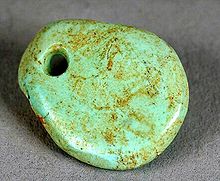 Trade in turquoise crafts, such as this freeform pendant dating from 1000–1040 CE, is believed to have brought the Ancestral Puebloans of the Chaco Canyon great wealth.
Trade in turquoise crafts, such as this freeform pendant dating from 1000–1040 CE, is believed to have brought the Ancestral Puebloans of the Chaco Canyon great wealth.
 Moche turquoise nose ornament. Larco Museum Collection. Lima-Peru
Moche turquoise nose ornament. Larco Museum Collection. Lima-Peru
 The iconic gold burial mask of Tutankhamun, inlaid with turquoise, lapis lazuli, carnelian and coloured glass.
The iconic gold burial mask of Tutankhamun, inlaid with turquoise, lapis lazuli, carnelian and coloured glass.
The pastel shades of turquoise have endeared it to many great cultures of antiquity: it has adorned the rulers of Ancient Egypt, the Aztecs (and possibly other Pre-Columbian Mesoamericans), Persia, Mesopotamia, the Indus Valley, and to some extent in ancient China since at least the Shang Dynasty.[9] Despite being one of the oldest gems, probably first introduced to Europe (through Turkey) with other Silk Road novelties, turquoise did not become important as an ornamental stone in the West until the 14th century, following a decline in the Roman Catholic Church's influence which allowed the use of turquoise in secular jewellery. It was apparently unknown in India until the Mughal period, and unknown in Japan until the 18th century. A common belief shared by many of these civilizations held that turquoise possessed certain prophylactic qualities; it was thought to change colour with the wearer's health and protect him or her from untoward forces.
The Aztecs inlaid turquoise, together with gold, quartz, malachite, jet, jade, coral, and shells, into provocative (and presumably ceremonial) mosaic objects such as masks (some with a human skull as their base), knives, and shields. Natural resins, bitumen and wax were used to bond the turquoise to the objects' base material; this was usually wood, but bone and shell were also used. Like the Aztecs, the Pueblo, Navajo and Apache tribes cherished turquoise for its amuletic use; the latter tribe believe the stone to afford the archer dead aim. Among these peoples turquoise was used in mosaic inlay, in sculptural works, and was fashioned into toroidal beads and freeform pendants. The Ancestral Puebloans (Anasazi) of the Chaco Canyon and surrounding region are believed to have prospered greatly from their production and trading of turquoise objects. The distinctive silver jewelry produced by the Navajo and other Southwestern Native American tribes today is a rather modern development, thought to date from circa 1880 as a result of European influences.
In Persia, turquoise was the de facto national stone for millennia, extensively used to decorate objects (from turbans to bridles), mosques, and other important buildings both inside and out, such as the Medresseh-I Shah Husein Mosque of Isfahan. The Persian style and use of turquoise was later brought to India following the establishment of the Mughal Empire there, its influence seen in high purity gold jewellery (together with ruby and diamond) and in such buildings as the Taj Mahal. Persian turquoise was often engraved with devotional words in Arabic script which was then inlaid with gold.
Cabochons of imported turquoise, along with coral, was (and still is) used extensively in the silver and gold jewellery of Tibet and Mongolia, where a greener hue is said to be preferred. Most of the pieces made today, with turquoise usually roughly polished into irregular cabochons set simply in silver, are meant for inexpensive export to Western markets and are probably not accurate representations of the original style.
The Egyptian use of turquoise stretches back as far as the First Dynasty and possibly earlier; however, probably the most well-known pieces incorporating the gem are those recovered from Tutankhamun's tomb, most notably the Pharaoh's iconic burial mask which was liberally inlaid with the stone. It also adorned rings and great sweeping necklaces called pectorals. Set in gold, the gem was fashioned into beads, used as inlay, and often carved in a scarab motif, accompanied by carnelian, lapis lazuli, and in later pieces, coloured glass. Turquoise, associated with the goddess Hathor, was so liked by the Ancient Egyptians that it became (arguably) the first gemstone to be imitated, the fair structure created by an artificial glazed ceramic product known as faience. (A similar blue ceramic has been recovered from Bronze Age burial sites in the British Isles.)
The French conducted archaeological excavations of Egypt from the mid-19th century through the early 20th. These excavations, including that of Tutankhamun's tomb, created great public interest in the western world, subsequently influencing jewellery, architecture, and art of the time. Turquoise, already favoured for its pastel shades since c. 1810, was a staple of Egyptian Revival pieces. In contemporary Western use, turquoise is most often encountered cut en cabochon in silver rings, bracelets, often in the Native American style, or as tumbled or roughly hewn beads in chunky necklaces. Lesser material may be carved into fetishes, such as those crafted by the Zuni. While strong sky blues remain superior in value, mottled green and yellowish material is popular with artisans. In Western culture, turquoise is also the traditional birthstone for those born in the month of December. The turquoise is also a stone in the Jewish High Priest's breastplate, described in Exodus 28.
Culture
In many cultures of the Old and New Worlds, this gemstone has been esteemed for thousands of years as a holy stone, a bringer of good fortune or a talisman. It really does have the right to be called a 'gemstone of the peoples'. The oldest evidence for this claim was found in Ancient Egypt, where grave furnishings with turquoise inlay were discovered, dating from approximately 3000 BC. In the ancient Persian Empire, the sky-blue gemstones were earlier worn round the neck or wrist as protection against unnatural death. If they changed colour, the wearer was thought to have reason to fear the approach of doom. Meanwhile, it has been discovered that the turquoise certainly can change colour, but that this is not necessarily a sign of impending danger. The change can be caused by the light, or by a chemical reaction brought about by cosmetics, dust or the acidity of the skin.
Imitations
The Egyptians were the first to produce an artificial imitation of turquoise, in the glazed earthenware product faience. Later glass and enamel were also used, and in modern times more sophisticated ceramics, porcelain, plastics, and various assembled, pressed, bonded, and sintered products (composed of various copper and aluminium compounds) have been developed: examples of the latter include "Viennese turquoise", made from precipitated aluminium phosphate coloured by copper oleate; and "neolith", a mixture of bayerite and copper phosphate. Most of these products differ markedly from natural turquoise in both physical and chemical properties, but in 1972 Pierre Gilson introduced one fairly close to a true synthetic (it does differ in chemical composition owing to a binder used, meaning it is best described as a simulant rather than a synthetic). Gilson turquoise is made in both a uniform colour and with black "spiderweb matrix" veining not unlike the natural Nevada material.
 Some natural blue to blue-green materials, such as this botryoidal chrysocolla with quartz drusy, are occasionally confused with, or used to imitate turquoise.
Some natural blue to blue-green materials, such as this botryoidal chrysocolla with quartz drusy, are occasionally confused with, or used to imitate turquoise.The most common imitation of turquoise encountered today is dyed howlite and magnesite, both white in their natural states, and the former also having natural (and convincing) black veining similar to that of turquoise. Dyed chalcedony, jasper, and marble is less common, and much less convincing. Other natural materials occasionally confused with or used in lieu of turquoise include: variscite and faustite;[10] chrysocolla (especially when impregnating quartz); lazulite; smithsonite; hemimorphite; wardite; and a fossil bone or tooth called odontolite or "bone turquoise", coloured blue naturally by the mineral vivianite. While rarely encountered today, odontolite was once mined in large quantities—specifically for its use as a substitute for turquoise—in southern France.
These fakes are detected by gemmologists using a number of tests, relying primarily on non-destructive, close examination of surface structure under magnification; a featureless, pale blue background peppered by flecks or spots of whitish material is the typical surface appearance of natural turquoise, while manufactured imitations will appear radically different in both colour (usually a uniform dark blue) and texture (usually granular or sugary). Glass and plastic will have a much greater translucency, with bubbles or flow lines often visible just below the surface. Staining between grain boundaries may be visible in dyed imitations.
Some destructive tests may, however, be necessary; for example, the application of diluted hydrochloric acid will cause the carbonates odontolite and magnesite to effervesce and howlite to turn green, while a heated probe may give rise to the pungent smell so indicative of plastic. Differences in specific gravity, refractive index, light absorption (as evident in a material's absorption spectrum), and other physical and optical properties are also considered as means of separation.
Treatments
Turquoise is treated to enhance both its colour and durability (i.e., increased hardness and decreased porosity). As is so often the case with any precious stones, full disclosure about treatment is frequently not given. It is therefore left to gemologists to detect these treatments in suspect stones using a variety of testing methods—some of which are necessarily destructive. For example, the use of a heated probe applied to an inconspicuous spot will reveal oil, wax, or plastic treatment with certainty.
Waxing and oiling
Historically, light waxing and oiling were the first treatments used in ancient times, providing a wetting effect, thereby enhancing the colour and lustre. This treatment is more or less acceptable by tradition, especially because treated turquoise is usually of a higher grade to begin with. Oiled and waxed stones are prone to "sweating" under even gentle heat or if exposed to too much sun, and they may develop a white surface film or bloom over time. (With some skill, oil and wax treatments can be restored.)
Stabilization
Material treated with plastic or water glass is termed "bonded" or "stabilized" turquoise. This process consists of pressure impregnation of otherwise unsaleable chalky American material by epoxy and plastics (such as polystyrene) and water glass (sodium silicate) to produce a wetting effect and improve durability. Plastic and water glass treatments are far more permanent and stable than waxing and oiling, and can be applied to material too chemically or physically unstable for oil or wax to provide sufficient improvement. Conversely, stabilization and bonding are rejected by some as too radical an alteration.[11]
The epoxy binding technique was first developed in the 1950s and has been attributed to Colbaugh Processing of Arizona, a company that still operates today. The majority of American material is now treated in this manner although it is a costly process requiring many months to complete. Without such impregnation, most American mining operations would be unprofitable.
Dyeing
The use of Prussian blue and other dyes (often in conjunction with bonding treatments) to "enhance"—that is, make uniform or completely change—colour is regarded as fraudulent by some purists,[11] especially since some dyes may fade or rub off on the wearer. Dyes have also been used to darken the veins of turquoise.
Reconstitution
Perhaps the most radical of treatments is "reconstitution", wherein fragments of fine turquoise material, too small to be used individually, are powdered and then bonded to form a solid mass. Much, if not all, of this "reconstituted" material is likely artificial with no natural components, or may have foreign filler material added to it.
Backing
Since finer turquoise is often found as thin seams, it may be glued to a base of stronger foreign material as a means of reinforcement. These stones are termed "Backed" and it is standard practice that all thinly cut turquoise in the Southwestern United States is backed. Native indigenous peoples of this region, because of their considerable use and wearing of turquoise, found that backing increased the durability of thinly cut slabs and cabs of turquoise. They observed that if the stone was not backed it would, for the most part, end up cracking. Early backing materials were the casings of old model T batteries and progressed to old phonograph records and most recently to the use of epoxy steel resins. Backing of turquoise is not known outside of the Native American and Southwestern United States jewelry trade. The value of turquoise of the highest quality is not discounted because it is backed and indeed the process is expected for most thinly cut American commercial gemstones.[citation needed]
Valuation and care
American Robin nest and eggs
Hardness and richness of colour are two of the major factors in determining the value of turquoise; while colour is a matter of individual taste, generally speaking, the most desirable is a strong sky to "robin's egg" blue (in reference to the eggs of the American Robin).[8] Whatever the colour, turquoise should not be excessively soft or chalky; even if treated, such lesser material (to which most turquoise belongs) is liable to fade or discolour over time and will not hold up to normal use in jewellery.
The mother rock or matrix in which turquoise is found can often be seen as splotches or a network of brown or black veins running through the stone in a netted pattern; this veining may add value to the stone if the result is complementary, but such a result is uncommon. Such material is sometimes described as "spiderweb matrix"; it is most valued in the Southwest United States and Far East, but is not highly appreciated in the Near East where unblemished and vein-free material is ideal (regardless of how complementary the veining may be). Uniformity of colour is desired, and in finished pieces the quality of workmanship is also a factor; this includes the quality of the polish and the symmetry of the stone. Calibrated stones—that is, stones adhering to standard jewellery setting measurements—may also be more sought after. Like coral and other opaque gems, turquoise is commonly sold at a price according to its physical size in millimetres rather than weight.
Turquoise is treated in many different ways, some more permanent and radical than others. Controversy exists as to whether some of these treatments should be acceptable, but one can be more or less forgiven universally: This is the light waxing or oiling applied to most gem turquoise to improve its colour and lustre; if the material is of high quality to begin with, very little of the wax or oil is absorbed and the turquoise therefore does not "rely" on this impermanent treatment for its beauty. All other factors being equal, untreated turquoise will always command a higher price. Bonded and "reconstituted" material is worth considerably less.
Being a phosphate mineral, turquoise is inherently fragile and sensitive to solvents; perfume and other cosmetics will attack the finish and may alter the colour of turquoise gems, as will skin oils, as will most commercial jewelry cleaning fluids. Prolonged exposure to direct sunlight may also discolour or dehydrate turquoise. Care should therefore be taken when wearing such jewels: cosmetics, including sunscreen and hair spray, should be applied before putting on turquoise jewellery, and they should not be worn to a beach or other sun-bathed environment. After use, turquoise should be gently cleaned with a soft cloth to avoid a build up of residue, and should be stored in its own container to avoid scratching by harder gems. Turquoise can also be adversely affected if stored in an airtight container.
See also
Notes
- ^ Hurlbut, Cornelius S.; Klein, Cornelis, 1985, Manual of Mineralogy, 20th ed., John Wiley and Sons, New York ISBN 0-471-80580-7
- ^ a b c "Turquoise:turquoise mineral information and data". mindat.org. http://www.mindat.org/min-4060.html. Retrieved 2006-10-04.
- ^ a b http://rruff.geo.arizona.edu/doclib/hom/turquoise.pdf Handbook of Mineralogy
- ^ a b Palache, C., H. Berman, and C. Frondel (1951) Dana’s system of mineralogy, Wiley, 7th ed., vol. II, pp. 946-951
- ^ a b c USGS Turquoise
- ^ Minerals of Nevada - Nevada Bureau of Mines Special Pub. 31 Pages 78-81; 443-445
- ^ "Turquoise Crystal Localities". Element 51. http://www.element51.com/article1.htm. Retrieved 2006-09-23.
- ^ a b ""Turquoise – The Gemstone of Tibet ", Article by Gemmologist Martin Watson". http://www.dharamsalanet.com/links/articles/turquoise.htm. Retrieved 2007-06-01.
- ^ "China Exhibition". Washington D.C.: National Gallery of Art. 1999. http://www.nga.gov/exhibitions/china1999/096_053.htm. Retrieved 2006-09-23.
- ^ "U.S. Geological Survey article on Turquoise". http://minerals.usgs.gov/minerals/pubs/commodity/gemstones/sp14-95/turquoise.html. Retrieved 2007-06-01.
- ^ a b ""Turquoise", Article by Journalist Joseph A. Harriss". Archived from the original on 2008-02-01. http://web.archive.org/web/20080201025038/http://www.geocities.com/harriss75007/turquois.htm. Retrieved 2007-06-01.
References
- British Museum (2000). Aztec turquoise mosaics. Retrieved November 15, 2004 from www.thebritishmuseum.ac.uk
- Dietrich, R. V. (2004). Turquoise. Retrieved November 20, 2004 from www.cst.cmich.edu/users/dietr1rv/turquoise.htm
- Persian Turquoise Mine [1]
- Hurlbut, Cornelius S.; Klein, Cornelis, 1985, Manual of Mineralogy, 20th ed., John Wiley and Sons, New York ISBN 0-471-80580-7
- King, R. J. (2002) Turquoise. Geology Today 18 (3), pp. 110–114. Retrieved November 24, 2004, from: www.blackwell-synergy.com/links/doi/10.1046/j.1365-2451.2002.00345.x/full/
- Pogue, J. E. (1915). The turquoise: a study of its history, mineralogy, geology, ethnology, archaeology, mythology, folklore, and technology. National Academy of Sciences, The Rio Grande Press, Glorieta, New Mexico. ISBN 0-87380-056-7
- Schadt, H. (1996). Goldsmith's art: 5000 years of jewelry and hollowware. Arnoldsche Art Publisher, Stuttgart, New York. ISBN 3-925369-54-6
- Schumann, W. (2000). Gemstones of the world, revised edition. Sterling Publishing. ISBN 0-8069-9461-4
- USGS (2002). Turquoise. An overview of production of specific U.S. gemstones. U.S. Bureau of Mines Special Publication 14-19. Retrieved November 15, 2004 from http://minerals.usgs.gov/minerals/pubs/commodity/gemstones/sp14-95/turquoise.html
- Webster, R. (2000). Gems: Their sources, descriptions and identification (5th ed.), pp. 254–263. Butterworth-Heinemann, Great Britain. ISBN 0-7506-1674-1
External links
Phosphate minerals Crystalline Beraunite · Brazilianite · Eosphorite · Fluorapatite · Hydroxylapatite · Lithiophilite · Metatorbernite · Monazite · Struvite · Taranakite · Variscite · WavelliteCryptocrystalline Turquoise · WhitlockiteAmorphous Jewellery Forms Anklet · Belt buckle · Belly chain · Bindi · Bracelet · Brooch · Chatelaine · Collar pin · Crown · Cufflink · Earring · Lapel pin · Necklace · Pendant · Ring · Tiara · Tie clip · Toe ring · Watch (pocket)Making PeopleProcessesCasting (centrifugal, lost-wax, vacuum) · Enameling · Engraving · Filigree · Metal clay · Plating · Polishing · Repoussé and chasing · Soldering · Stonesetting · Wire wrappingToolsMaterials Precious metal alloysBritannia silver · Colored gold · Crown gold · Electrum · Platinum sterling · Shakudo · Shibuichi · Sterling silver · TumbagaMineral gemstonesAventurine · Agate · Alexandrite · Amethyst · Aquamarine · Carnelian · Citrine · Diamond · Diopside · Emerald · Garnet · Jade · Jasper · Lapis lazuli · Larimar · Malachite · Marcasite · Moonstone · Obsidian · Onyx · Opal · Peridot · Quartz · Ruby · Sapphire · Sodalite · Sunstone · Tanzanite · Tiger's eye · Topaz · Tourmaline · TurquoiseOrganic gemstonesTerms Categories:- Phosphate minerals
- Aluminium minerals
- Copper minerals
- Gemstones
- Symbols of New Mexico
- Triclinic minerals
Wikimedia Foundation. 2010.

